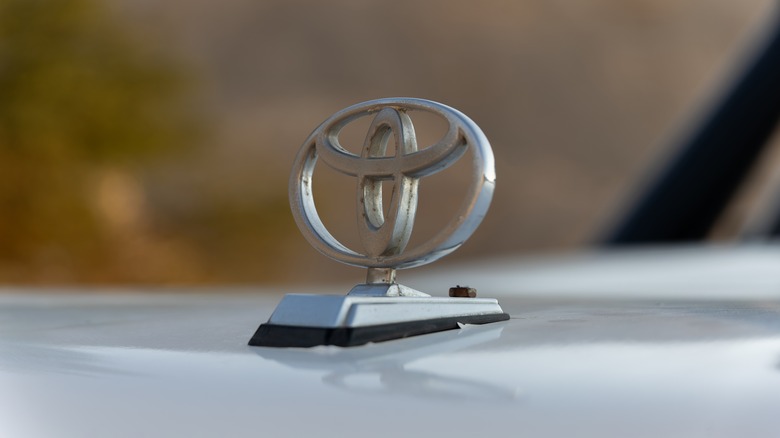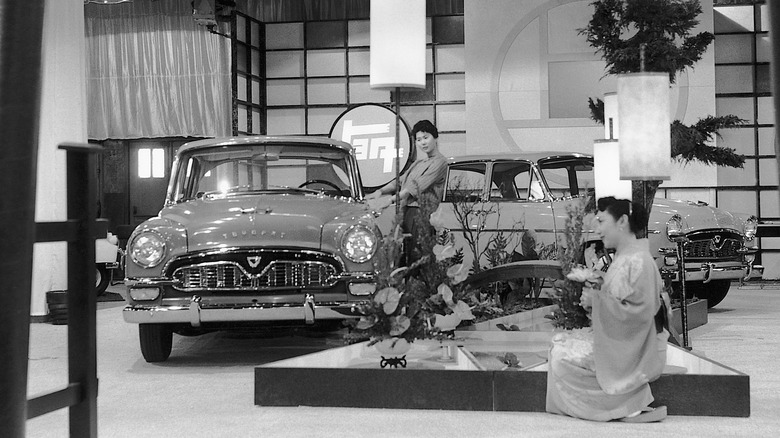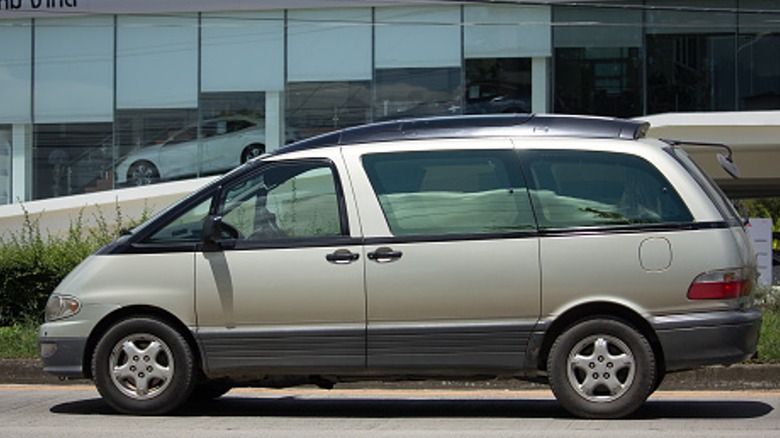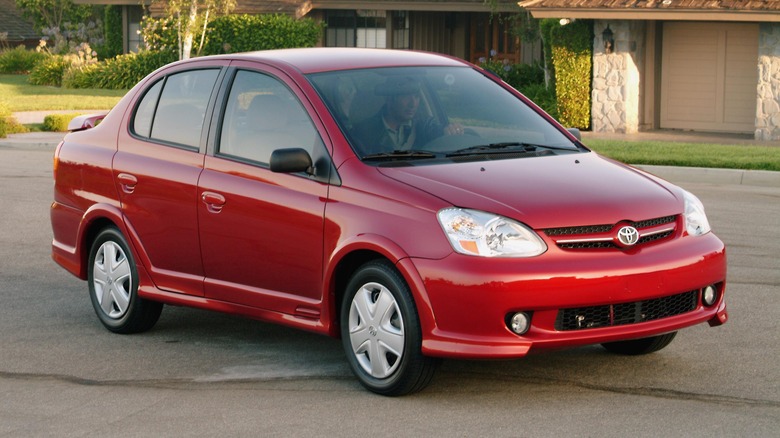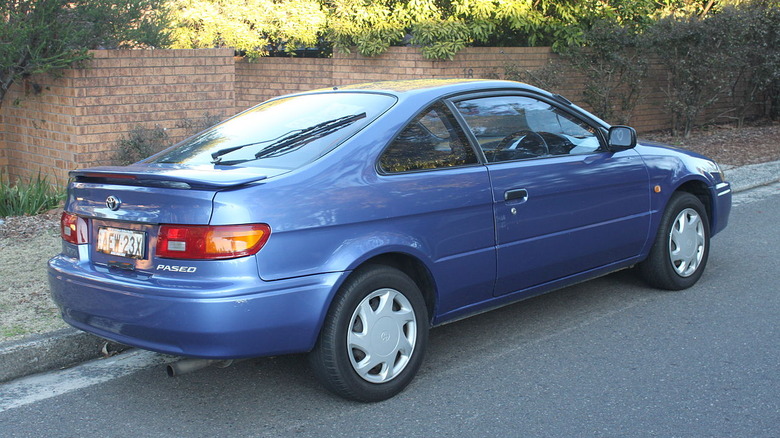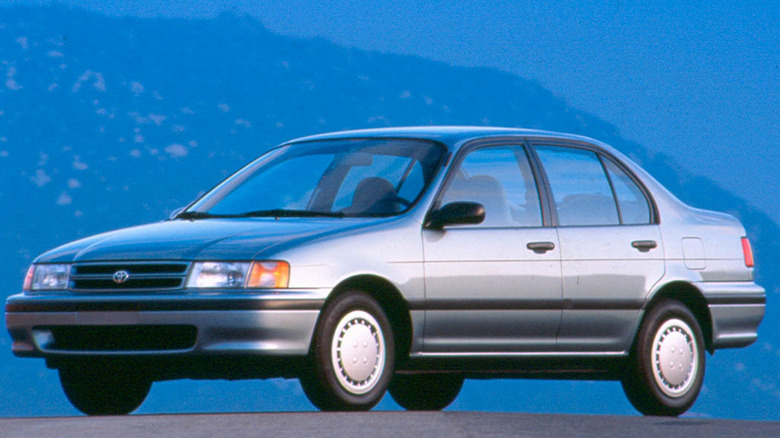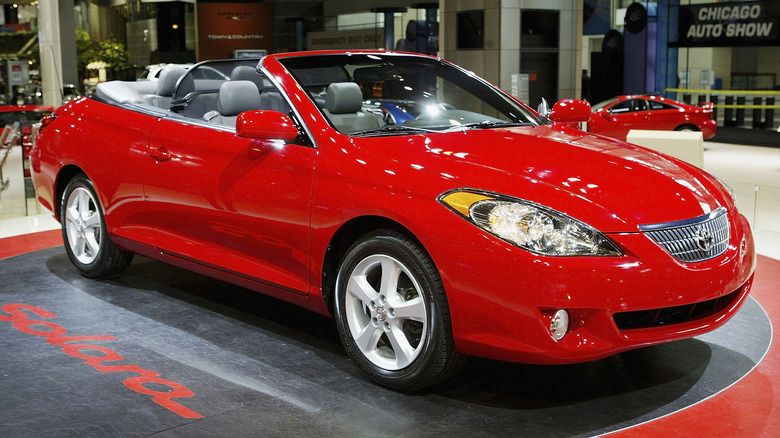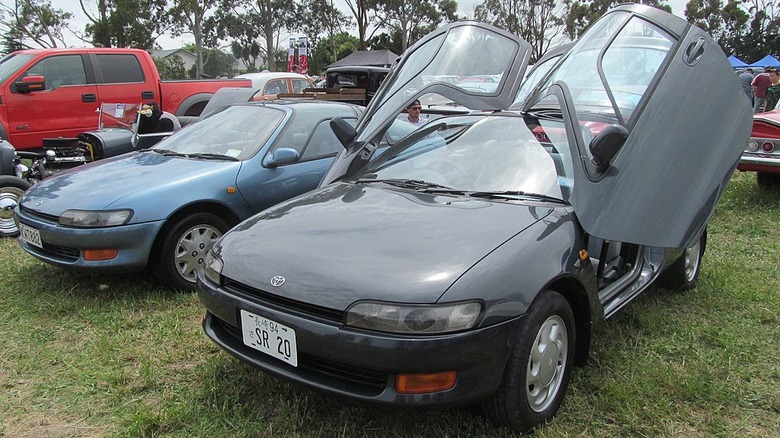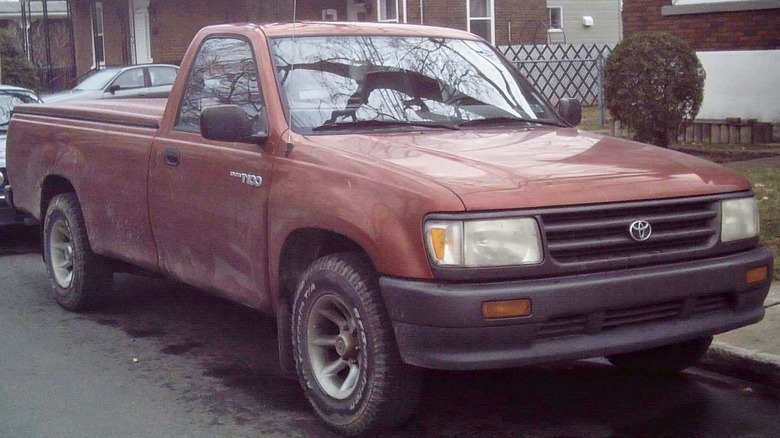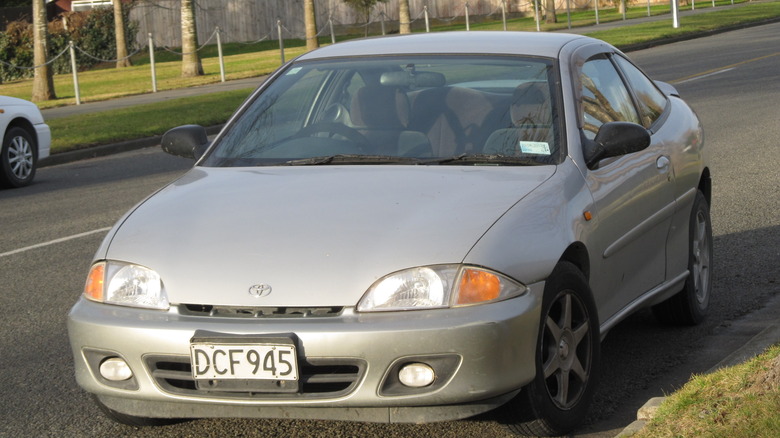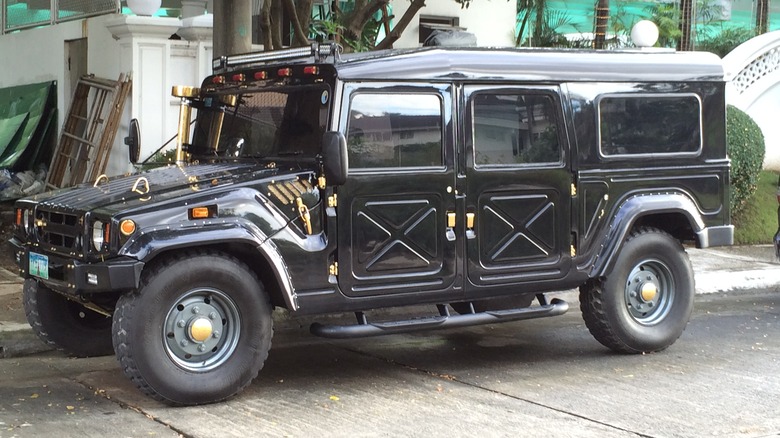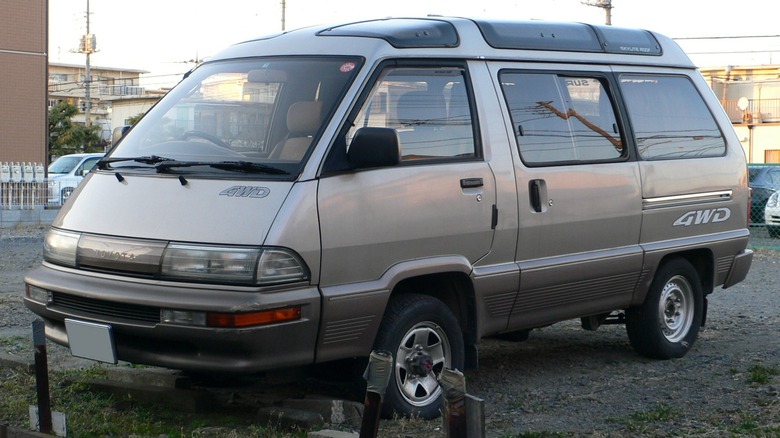Toyota's Biggest Car Flops Of All Time
If you grew up obsessed with cars, you probably admire Toyota. The Japanese automotive giant has built a reputation for reliability, innovation, and quality over decades. Who didn't dream of owning a sturdy Corolla, a fancy Camry, or some of the most iconic cars of all time made by Toyota as their first ride? But no automaker is perfect, as Toyota themselves will tell you.
Behind their many successes and industry-leading models lie a few notable productions that fell far short of expectations, showing that even the best of the best sometimes miss the mark. These vehicles were assumed to be breakthrough designs primed for mainstream success, yet rather became failures that left a mark. However, not positively.
From quirky designs that raised eyebrows to ambitious concepts that flopped harder than a lead balloon, Toyota's history is littered with a few lemons that make you wonder, "What were they thinking?" These cars, which initially held so much promise, ultimately left a lasting impression on the company, but not in the way Toyota had hoped.
Toyopet Crown (1955 - 1962)
The Toyopet Crown had the honor of being Toyota's longest-running model. According to RememberRoad, the Crown initially found success when first launched in post-war 1950s Japan. However, its fortunes dramatically changed once exported to the expansive American market.
At under 100 inches in width, the petite Crown suddenly felt cramped compared to the road-dominating land yachts cruising highways from Detroit's Big Three. Puny beside hulking cars like Fords and Chevrolets, the sedan faced an uphill battle appealing to car-centric U.S. consumers accustomed to unabashed V8 muscle.
Saddled with a heavy steel body and leisurely zero to 60 mph exceeding 25 seconds, the Crown lacked the power metrics to satisfy performance-oriented buyers. Its meager power was further compromised, lugging around 2,685 lbs of mass. Toyota also failed to court the critical American audience adequately. With a limited dealership footprint primarily clustered in California, brand recognition was virtually non-existent outside the Golden State. The ambiguous "Toyopet" name also did little to inspire confidence that this was a serious saloon and not a toy.
Eventually, Toyota withdrew the Crown from America in 1960 after it became apparent the model was not welcome — although it would return over 60 years later with a new hybrid powertrain.
Toyota Previa (1991-1997)
The Previa turned heads upon its debut with its distinctive egg-shaped silhouette and novel mid-engine layout. However, Toyota may have prioritized style over substance with this unconventional configuration. With the engine crammed beneath the front seats rather than ahead, technicians struggled to access it for repairs. Its maintenance involved more time and contortions than competing minivans with straightforward designs. Such impractical servicing concerns posed problems for both dealers and customers needing timely, affordable repairs.
The performance also left much to be desired. The standard 2.4-liter four-cylinder, producing just 138 horsepower, could barely hustle a full passenger and cargo load up to highway speeds. A supercharged optional upgrade boosted output to just 161 horsepower. Deseret News testing revealed that even the supercharged Previa barely eked out over 21 MPG mixed—mediocre returns given the efficiency standards of the day.
Distinctive looks and styling alone did not assure family safety or convince minivan shoppers in this practical market. As families grew increasingly safety-conscious in the 1990s, Previa's poor ratings from the Insurance Institute for Highway Safety (IIHS) in frontal crash testing raised red flags among buyers. While other manufacturers strengthened protections, Toyota allowed this oddball's performance to fall behind.
These issues culminated in dismal sales numbers for the Previa in the US market before Toyota pulled the plug in 1997.
Toyota Echo (2000 - 2005)
Designed as a budget-friendly option for young drivers, the Toyota Echo was supposed to be a sales success. However, the Echo fell short of expectations in multiple critical areas. Most notably, the base model of the Echo's interior lacked numerous standard features auto buyers had grown to expect. Without basic amenities like power steering, air conditioning, power locks, a rear defroster, a decent audio system, or even folding rear seats, the stripped-down cabin appeared dated next to competitors offering greater value.
The Toyota Echo's exterior styling was controversial, with its narrow proportions drawing much criticism. At a longer length than its global counterparts, the Echo adopted a cab-forward look with a short, steeply-raked hood that invoked comparisons to minivans rather than a sleek coupe. In sharp contrast stood the Toyota Yaris, which elegantly concealed its height through wedge-like styling welcomed in the competitive European marketplace.
Unsurprisingly, the Echo's polarizing aesthetics were a tough sell stateside. Sales took a year-over-year nosedive until Toyota mercifully put the model out to pasture after 2005. However, it continued to be produced globally under the Yaris nameplate.
Toyota Paseo (1991– 1999)
The early Toyota Paseo models were designed exclusively as coupes. Later, the design was modified to offer buyers the choice of a convertible soft top, seemingly meant to attract buyers looking for options like the popular Honda Del Sol of the same era. Powered by a 1.5-liter four-cylinder engine, the Paseo unleashed a modest 90 hp and 96 lb-ft of torque channeled through a five-speed manual or a four-speed automatic transmission. Its powertrain was somewhat humble compared to competitors of the time, such as Del Sol, which offered 106 hp from its 1.6-liter engine.
Despite Toyota's solid reputation, Paseo owners frequently reported issues that undercut the car's image. According to RepairPal, Problems included engine trouble, electrical gremlins, and wheel concerns. Specific examples include the automatic transmission failing to shift crisply at high miles, wonky ignition coils, manual transmissions popping out of gear due to worn bushings, emissions failure, and rough idling from improperly adjusted valves.
While the Paseo's exterior embodied sleek allure, its interior fell short of such grace. The high beltline and low roof conspired to create enlarged windows and thin pillars, cultivating a claustrophobic and cramped ambiance within. Initially basking in popularity during the early 1990s with 36,513 units sold during 1992 in the U.S., Paseo's sales steadily declined, plummeting to a mere 194 units in 1998. This dismal performance ultimately sealed the car's fate, leading to its departure from the United States market that year
[Featured image by Jeremy via Wikimedia Commons | Cropped and scaled | CC BY-SA 2.0]
Toyota Tercel (1978 –1999)
The Toyota Tercel, which debuted in August 1978, marked Toyota's initial venture into front-wheel drive vehicles, which aimed to provide affordable transportation between the little-known Starlet and popular Corolla models. It was initially offered as a two-door or four-door sedan, with a three-door hatchback added later to appeal to various customer needs.
Sales figures indicate that Tercel's popularity grew substantially in the 1980s, with annual sales exceeding 100,000 units in peak years such as 1987. However, by the late 1990s, its sales had sharply declined, falling to only 46 units sold in the United States in its final year, 1999. This steep drop was likely due to heightened competition and evolving consumer preferences for more modern features.
While renowned for dependability and fuel efficiency, the Tercel confronted recurring technical issues, as owners encountered engine oil leaks, transmission problems, brake failures, and electrical glitches. Critics noted the Tercel's uninspired styling lacked a sportier variant that could have broadened its appeal. Some found it to look unique but unconventional, taking time to appreciate. The lack of an independent rear suspension also disadvantaged it over its peers, while the car's interior was described as adequate but cramped, with undesirable engine, wind, and road noise.
The combination of technical flaws, design criticisms, and noise ultimately diminished Tercel's market presence by the end of the century.
Toyota Camry Solara (1999 – 2008)
The Toyota Solara, introduced in the late 1990s, aimed to fill the void left by the discontinued Camry Coupe and appeal to drivers seeking a sportier driving experience. Despite its shared mechanical components with the Camry, Solara didn't quite deliver on its promise of a truly sporty ride. While it boasted a smooth ride, well-appointed cabin, and quiet interior, it fell short in terms of providing an engaging driving experience.
In 2004, the Solara underwent a redesign that brought about significant changes. However, this redesign was accompanied by a notable number of complaints. These ranged from interior accessory issues like dashboard cracking to problems with seat belts, airbags, and even the engine. These issues were detailed on REREV, providing insights into the worst Solara model years to avoid — namely, 2000, 2004, 2006, and 2007
Some critics described the Toyota Camry Solara's exterior styling as too curvy without being trendy, while identifying the rear section's drooping look as a potential design flaw. Ultimately, Solara's sales performance fell short of Toyota's expectations, leading to its discontinuation in 2008, nearly a decade after its initial launch.
Toyota Sera (1990 – 1996)
The Toyota Sera was a bizarre sports coupe that captured attention upon release. Drawing inspiration from the Toyota AXV-II concept, the Sera stood out with its gull-wing doors that swung upwards along with a distinctive bubble-top roof. Powered acceptably by a 1.5-liter four-cylinder engine producing around 108 horsepower, the lightweight Sera could be enjoyed with a manual or automatic transmission.
While the novel design makes it a head-turner, the Sera was plagued by nagging problems such as electrical troubles, faulty sensors, faulty alternator, and blown fuses, among hosts of other issues requiring deep pockets to remedy. Still, its place in automotive history is deservedly secured. As the Sera was essentially a Kei car built for worldwide sales, it never made its way to the North American market due to its inability to meet the stringent safety standards in the United States. As a result, American consumers never had the opportunity to experience the avant-garde styling cues and compact footprint of the quirky Sera firsthand.
Despite commercial hurdles, the Toyota Sera left an indelible mark. Its innovative doors predated those of the legendary McLaren F1 supercar, showing the Sera's progressive spirit. Over time, it grew a cult following among aficionados, especially collectors able to import one as a classic.
[Featured image by Riley via Wikimedia Commons | Cropped and scaled | CC BY-SA 2.0]
Toyota T100 (1992 – 1998)
The T100 was Toyota's first attempt at offering a full-size pickup truck to North American consumers. Designed as a middle ground between mid-size and full-size trucks, it targeted customers seeking more capability than compact trucks without the sheer heft of traditional American full-sizers. Although classified as full-size, the T100 cut a considerably slimmer figure, especially in width, compared to its Ford, GMC, and Dodge counterparts.
However, where the T100 really stumbled was under the hood. At launch, it packed one of Toyota's least reliable engines – the 3VZ-E 3.0-liter V6. A gutsier 3.4-liter V6 followed, but lacking a V8 option hamstrung it badly. The American full-size truck market has traditionally favored powerful V8 engines for their towing capacity and overall performance. The T100's V6s, even upgraded, couldn't match the power and capability U.S. buyers demanded from a full-size hauler.
The T100's tepid sales prompted Toyota to rethink its full-size truck strategy. Recognizing the need for a stronger contender, it axed the T100 in 1998 and replaced it with the Toyota Tundra in 1999. The Tundra addressed the T100's flaws with a potent 4.7-liter V8 option and supersized dimensions that more closely matched American full-size trucks.
[Featured image by Bull-Doser via Wikimedia Commons | Cropped and scaled | Public Domain]
Toyota Cavalier (1996 – 2005)
The joint venture between GM and Toyota sought to introduce the Chevrolet Cavalier into the Japanese market under Toyota branding. However, the Cavalier struggled to gain traction in Japan, where high-quality domestic automakers dominated. Its branding as a Toyota also caused confusion, as underneath the badge it remained distinctly a Chevrolet.
Due to its large 2.4-liter engine, the Cavalier fell into the same displacement-based tax bracket as legendary vehicles like the Nissan Skyline, putting it at a pricing disadvantage. According to reports logged with RepairPal, the Chevrolet Cavalier faced criticism for its questionable build quality, which failed to meet the high standards of Japanese consumers. Several issues were mentioned, including malfunctioning turn signal switches, power window motors overheating and failing, and the check engine light illuminating due to gas cap problems.
Toyota made some alterations for the local market to improve its appeal, such as shifting from left-hand drive to right-hand drive and adjusting the dashboard. Still, these changes did little to improve sales. On top of these challenges, the Cavalier's sales volumes fell far below Toyota's forecast of 20,000 units annually. At its peak in 1996, the Cavalier only managed 11,467 sales for the year in Japan. From 1995 to 2000, barely 36,216 units were sold — clear signs the vehicle did not resonate with buyers in this tough market dominated by domestic marques with strong quality credentials.
[Featured image by Riley via Wikimedia Commons | Cropped and scaled | CC BY-SA 2.0]
Toyota Mega Cruiser (1995 – 2002)
The Toyota Mega Cruiser was initially conceived for military purposes, resulting in a rugged and robust design. With its imposing exterior dimensions and formidable powertrain, the Mega Cruiser appeared ready to take on the iconic Hummer head-on in the competitive off-road vehicle market of the mid-1990s. However, the Mega Cruiser's size proved ill-suited for everyday driving in its domestic Japanese market. With city streets notoriously narrow and high taxes discouraging large vehicles, it wasn't a practical family hauler for most buyers. This mismatch with local market conditions doomed the Mega Cruiser despite its rugged prowess off the pavement.
In contrast, the Hummer lineup, built by AM General and later marketed by General Motors, found immense success internationally and achieved a level of celebrity cachet that eluded its Japanese rival. As such, the Mega Cruiser was discontinued in 2001, and its sales were officially halted in 2002 after a mere 3,000 units rolled off the production line during its brief lifespan. Remarkably, only 133 of these vehicles were purchased by civilian owners. It was a disheartening end for a vehicle that had shown such promise on paper.
However, the Mega Cruiser's failure in the mainstream market has unexpectedly turned it into a rare and coveted item for collectors. In a remarkable turn of events, a 1996 model of the Mega Cruiser was sold at auction for an astonishing $310,000 in 2022 on Cars & Bids.
[Featured image by Ominae via Wikimedia Commons | Cropped and scaled | CC BY-SA 4.0]
Toyota Van (1982 – 1992)
The Toyota MasterAce Surf van is known by various names in different markets, including the Toyota Van in North America and the Toyota Space Cruiser in parts of Europe. One of the primary challenges the MasterAce Surf faced was stiff competition, particularly in the United States. When introduced to the American market in the 1984 model year, it went up against Chrysler's minivans, which better suited American tastes and needs. Chrysler's minivans offered more interior space and were more in line with what American families were looking for in a vehicle of this type.
Reliability issues, particularly blown head gaskets on the similar Townace model that could lead to overheating and warped heads if not addressed quickly, further tarnished the MasterAce Surf's reputation stateside. Even the MasterAce Surf's optional ice maker was not enough to sway consumers as the additional cost of this feature — which required the dual air conditioning option — made the vehicle significantly more expensive.
While the MasterAce Surf's mid-engine layout under the front seats was innovative, it severely limited interior room, putting it at a disadvantage against its roomier competitors. The uninspiring Toyota Van name in North America didn't help matters either. Initially dubbed the Van Wagon, that name was quickly axed after Volkswagen reportedly claimed it sounded too close to their Vanagon.
[Featured image by Mytho88 via Wikimedia Commons | Cropped and scaled | CC BY-SA 3.0]
